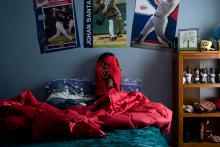Carmen Papalia on the art of nonvisual learning
By KristinOctober 11, 2014 - 23:40

Interesting piece by Carmen Papalia, who came to the bi-co as a Mellon Creative Resident in 2012. "Museums disable me as a viewer. Everything, from the artworks to the explanatory text, assumes a subject who uses their visual sense as a primary way of knowing, and I am a nonvisual learner who requires a different frame of reference."
http://blog.art21.org/2014/10/07/you-can-do-it-with-your-eyes-closed/#












